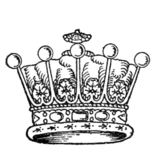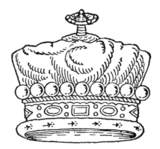The coronet of a viscount shows nine "pearls," all set closely together, directly upon the circlet (Fig. 651).
The coronet of a baron shows four "pearls" upon the circlet (Fig. 652). This coronet was assigned by Royal Warrant, dated 7th August, 12 Charles II., to Barons of England, and to Barons of Ireland by warrant 16th May, 5 James II.
All coronets of degree actually, and are usually represented to, enclose a cap of crimson velvet, turned up with ermine. None of them are permitted to be jewelled, but the coronet of a duke, marquess, earl, or viscount is chased in the form of jewels. In recent times, however, it has become very usual for peers to use, heraldically, for more informal purposes a representation of the circlet only, omitting the cap and the ermine edging.
 Fig. 648. |
 Fig. 649. |
 Fig. 650. |
 Fig. 651. |
 Fig. 652. |
The crown or coronet of a king of arms (Fig. 653) is of silver-gilt formed of a circlet, upon which is inscribed part of the first verse of the 51st Psalm, viz.: "Miserere mei Deus secundum magnam misericordiam tuam." The rim is surmounted with sixteen leaves, in shape resembling the oak-leaf, every alternate one being somewhat higher than the rest, nine of which appear in the profile view of it or in heraldic representations. The cap is of crimson satin, closed at the top by a gold tassel and turned up with ermine.
Anciently, the crown of Lyon King of Arms was, in shape, an exact replica of the crown of the King of Scotland, the only difference being that it was not jewelled.
Coronets of rank are used very indiscriminately on the Continent, particularly in France and the Low Countries. Their use by no means implies the same as with us, and frequently indicates little if anything beyond mere "noble" birth.
The Mauerkrone [mural crown] (Fig. 654) is used in Germany principally as an adornment to the arms of towns. It is borne with three, four, or five battlemented towers. The tincture, likewise, is not

